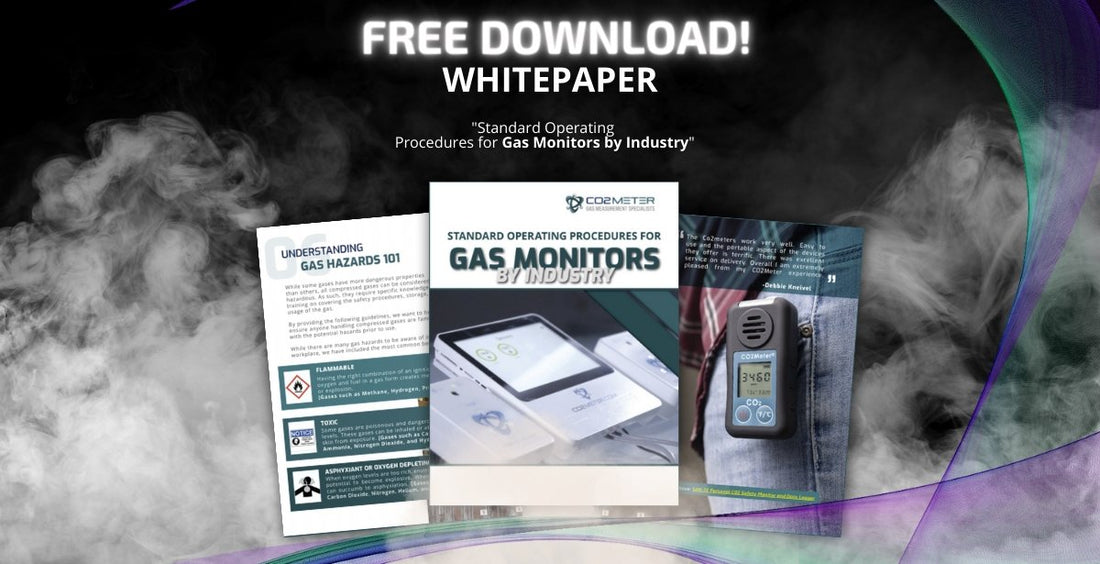
Hazardous gases are an invisible threat in many industries, from laboratories and industrial manufacturing to food production and breweries.
To reduce risk, it’s critical to establish and follow Standard Operating Procedures (SOPs) for gas detection safety. And, at CO2Meter, we have created a free whitepaper that outlines step-by-step procedures for ensuring your gas detection safety systems are reliable, accurate, and effective - no matter your industry or environment.
Why SOPs for Gas Detection Monitors are Critical
When it comes to gas safety, inconsistency can be incredibly dangerous. That is why standard operating procedures (SOPs) provide a true framework that ensures both personnel and facilities can handle gas detection monitors in a consistent, informed, and safe manner.
From installation and calibration to alarm response and risk mitigation, SOPs remove the guesswork and reduce the chance of human error.
For facilities that deal with hazardous gases, it's important to treat SOPs not as guidelines, but as essential components of a safety culture. SOPs also help meet compliance requirements from regulatory agencies such as OSHA, NFPA, and local fire codes, making them a vital part of any audit-ready safety program.
Key Elements to Include in a Gas Detection SOP
A strong gas detection SOP should also outline every step of the monitor’s lifecycle, from selection and setup to calibration and maintenance. This includes procedures for regular sensor testing, alarm verification, and environmental assessments to ensure a gas safety monitor is functioning at optimal conditions.
In addition, SOPs should include emergency protocols, documentation standards, and clearly assigned roles for personnel. Every employee should understand what actions to take when a gas safety monitor detects elevated gas levels, and your SOP should make those steps easy to follow.
Best Practices for Monitoring Multiple Gases

Relying on a single gas monitor is no longer enough in environments where multiple hazardous gases are present. Multi-gas monitoring safety systems now offer broader protection by detecting a range of gases like CO2, O2, CH4, or H2, each of which can pose serious health and safety risks. (Learn more about multi gas exposure and health risks)
SOPs should address how to use and maintain multi-gas safety monitors, including calibration procedures for each sensor type and the need for comprehensive data logging. When SOPs are designed for gas detection safety, they can provide a more complete layer of protection and make your facility safer overall.
Download the CO2Meter Gas Detection SOP Whitepaper
CO2Meter’s SOP whitepaper is a practical, detailed guide built for professionals who use, store, or produce hazardous gases. It’s designed to help safety managers, beverage technicians, and facility operators create or refine their own internal procedures with proven best practices.
By downloading this resource, you’ll gain access to expert advice, customizable SOP templates, and a checklist that can be tailored to your specific industry.
It’s part of our ongoing mission to help customers build safer environments through knowledge, technology, and support.
What You’ll Learn in This Gas Hazard Safety Whitepaper:
- The Importance of Understanding Gas Hazards in the Workplace
- Key Gas Detection Regulations and Industry Standards
- Workplace Exposure Limits: A Beginner’s Guide
- Best Practices and SOPs for Gas Detection Monitors
- Industry-Specific Gas Hazards and Safety Recommendations
- Plus: Expert Insights, Compliance Tips, and More!
How To Create a Facility Gas Monitoring Strategy
Creating a comprehensive gas detection safety plan goes beyond installing gas safety monitors, it requires a clear strategy that integrates SOPs, staff training, routine maintenance, and emergency mitigation protocols. It's important to start by identifying potential gas hazards unique to your environment, then choose the appropriate gas detection safety device for each risk.
Your plan should include regular calibration schedules, documentation procedures, and clearly defined roles to ensure every team member knows how to respond in case of an alarm. By combining a formal gas detection safety plan with well-documented SOPs, you can significantly reduce risks and improve compliance with local safety standards and regulations.
We hope you find this resource to be both beneficial and insightful.
References:
- https://www.osha.gov/welding-cutting-brazing
- https://www.cganet.com/cylinder-and-equipment-safety/
- https://ehs.berkeley.edu/sites/default/files/publications/cryo-liquids-fact-sheet.pdf
- https://www.cganet.com/what-we-do/standards-publications/
- https://www.labmanager.com/lab-health-and-safety/science-laboratory-safety-rules-guidelines-5727
- https://www.osha.gov/publications/hib19960605#:~:text=The%20current%20OSHA%20standard%20is,can%20produce%20unconsciousness%20or%20death
- https://www.co2meter.com/blogs/news/inspection-code-updates-for-co2-monitoring
- https://www.co2meter.com/blogs/news/co2-tank-safety-precautions







